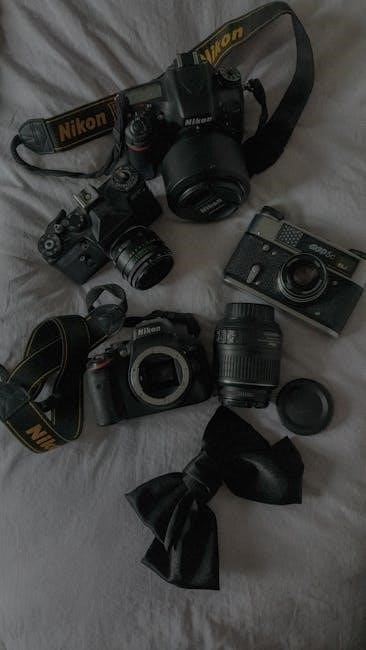The Nikon D3300 manual is a comprehensive guide designed to help photographers master their camera. It covers essential functions, advanced settings, and troubleshooting tips, ensuring optimal performance and creativity.

Overview of the Manual
The Nikon D3300 manual is a detailed guide that helps users understand and utilize their camera’s full potential. It includes a reference manual and a user manual, providing in-depth explanations of camera functions, settings, and features. The manual covers essential topics such as camera controls, shooting modes, autofocus configuration, and video recording capabilities. It also offers troubleshooting tips and maintenance advice to ensure optimal performance. Designed for photographers of all skill levels, the manual is structured to help beginners master the basics while offering advanced techniques for experienced users. Available in PDF format, the manual can be downloaded from Nikon’s official website or viewed via the Nikon Manual Viewer 2 app, making it accessible anytime, anywhere. This comprehensive resource ensures that users can explore every aspect of their D3300 and enhance their photography skills effectively.
Importance of Reading the Manual
Reading the Nikon D3300 manual is essential for unlocking the camera’s full potential and enhancing your photography experience. Whether you’re a beginner or an advanced user, the manual provides detailed insights into the camera’s features, allowing you to understand and utilize its capabilities effectively. It helps you master essential functions like autofocus, ISO settings, and shooting modes, while also offering troubleshooting solutions for common issues. The manual is a valuable resource for learning advanced techniques and customizing the camera to suit your creative needs. By familiarizing yourself with the manual, you can avoid technical challenges and ensure optimal performance. Additionally, the manual is available in PDF format and through the Nikon Manual Viewer 2 app, making it easily accessible for reference whenever needed. This comprehensive guide empowers you to take full control of your Nikon D3300 and capture stunning images with confidence.
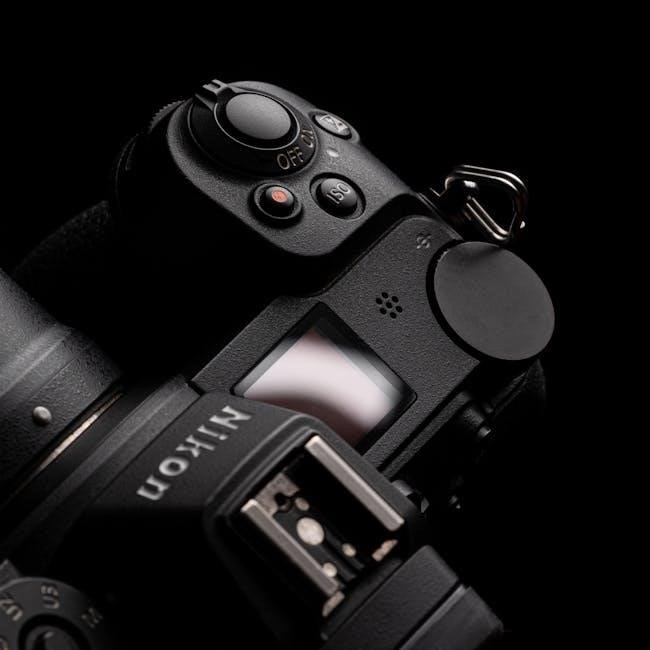
Key Features of the Nikon D3300
The Nikon D3300 features a 24.2MP CMOS sensor, ISO 100-12800, Full HD video recording, and an 11-point autofocus system, all in a lightweight, ergonomic design.
Design and Build Quality
The Nikon D3300 boasts a lightweight and durable design, making it an excellent choice for photographers who need a portable yet reliable DSLR. Its body is constructed from carbon fiber, ensuring both strength and a compact feel. Weighing just 410 grams, it is easy to carry for extended periods. The ergonomic grip provides a comfortable hold, allowing for intuitive control placement. The camera’s dimensions are 124mm x 98mm x 76mm, making it small enough for travel while remaining sturdy. The 3-inch LCD screen offers a clear view of images and settings, enhancing the overall user experience. Despite its entry-level positioning, the D3300’s build quality reflects Nikon’s commitment to durability and user comfort, catering to both beginners and enthusiasts alike.
Image Sensor and Processor
The Nikon D3300 is equipped with a 24.2-megapixel APS-C CMOS sensor, delivering high-resolution images with rich detail and vibrant colors. Paired with the EXPEED 4 image processor, it ensures fast and efficient image processing, enabling smooth operation and quick response times. The sensor captures a wide dynamic range, minimizing noise even in low-light conditions. This combination allows for crisp and clear images, whether shooting portraits, landscapes, or action shots. The EXPEED 4 processor also supports advanced features like continuous shooting at 5 frames per second and Full HD video recording at 60p. These technologies work together to provide photographers with the tools to capture professional-quality results, making the D3300 a versatile and powerful tool for both beginners and experienced shooters.
ISO Range and Performance
The Nikon D3300 features an ISO range of 100 to 12,800, extendable to 25,600, allowing photographers to shoot in a variety of lighting conditions. The EXPEED 4 processor effectively minimizes noise, even at higher ISO settings, ensuring sharp and detailed images. For optimal results, lower ISOs (100-800) are recommended for bright lighting to avoid noise and maintain the best possible image quality. In low-light situations, higher ISOs (1600-12,800) enable capturing images with minimal grain, though some noise may appear. The camera’s ISO performance is impressive for its class, making it suitable for both indoor and outdoor photography. By adjusting the ISO settings appropriately, users can achieve professional-looking results with reduced noise and improved clarity in their shots. This flexibility makes the D3300 a reliable choice for photographers who need to adapt to changing lighting environments.
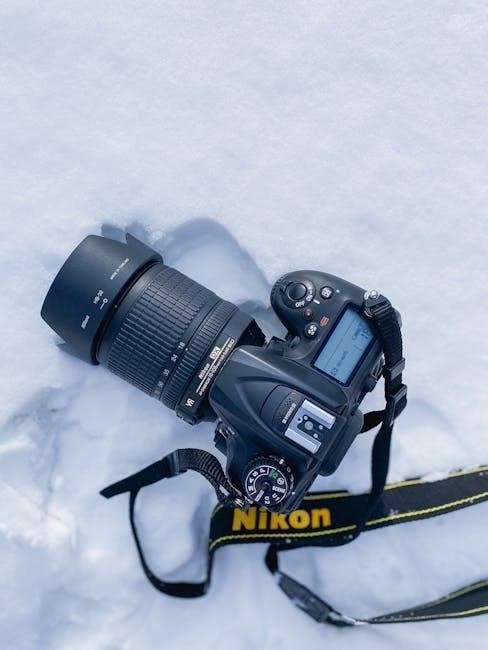
Camera Controls and Layout
The Nikon D3300 features an ergonomic design with intuitive controls, including a mode dial, navigation buttons, and customizable options, ensuring easy access to settings for seamless photography experiences.
External Controls Layout
The Nikon D3300 features a well-organized external control layout, designed for intuitive operation. The top panel includes a mode dial, offering quick access to shooting modes like Auto, P, S, A, and M. Adjacent to it is the shutter release button, surrounded by the power switch and movie recording button. On the rear, the multi-selector and navigation buttons simplify menu navigation and focus point selection. The live view and delete buttons are strategically placed for easy access. Customization options allow users to assign functions to specific buttons, enhancing workflow efficiency. The ergonomic grip and logical placement of controls ensure comfort and ease of use, even during extended shooting sessions. This layout caters to both beginners and experienced photographers, providing a seamless interface for capturing stunning images and videos.
Mode Dial and Shooting Modes
The Nikon D3300’s mode dial provides quick access to a variety of shooting modes, catering to different skill levels and creative preferences. The dial includes Auto Mode for point-and-shoot simplicity, Program Auto (P) for automatic settings with user-adjustable parameters, and Manual (M) for full control over aperture, shutter speed, and ISO. Additionally, the dial offers Shutter-Priority (S) and Aperture-Priority (A) modes, allowing photographers to control either shutter speed or aperture while the camera adjusts the other. Scene modes, such as Portrait, Landscape, and Night Portrait, optimize settings for specific shooting scenarios. Each mode empowers users to tailor their photography experience, whether capturing everyday moments or pursuing creative projects. The mode dial’s intuitive design ensures seamless transitions between settings, making it easy to adapt to changing conditions and achieve desired results.
Customization Options
The Nikon D3300 offers extensive customization options, allowing users to tailor the camera to their preferences and shooting style. The camera’s buttons can be reprogrammed to access frequently used settings, such as ISO or white balance, directly. Additionally, shooters can create custom shooting modes by saving specific combinations of settings under the “U1” and “U2” positions on the mode dial. This feature is particularly useful for photographers who often switch between different types of photography, such as switching from portraits to landscapes. Furthermore, the D3300 allows customization of the camera’s menu system, enabling users to hide or reorder menu items for quicker access to essential functions. These customization options enhance the user experience, making the camera more intuitive and efficient to operate during photo sessions. This level of personalization ensures that the D3300 adapts to individual needs, providing a seamless and enjoyable photography experience.

Shooting Modes and Settings
The Nikon D3300 offers various shooting modes and customizable settings, providing flexibility for photographers to capture stunning images in different conditions and styles.
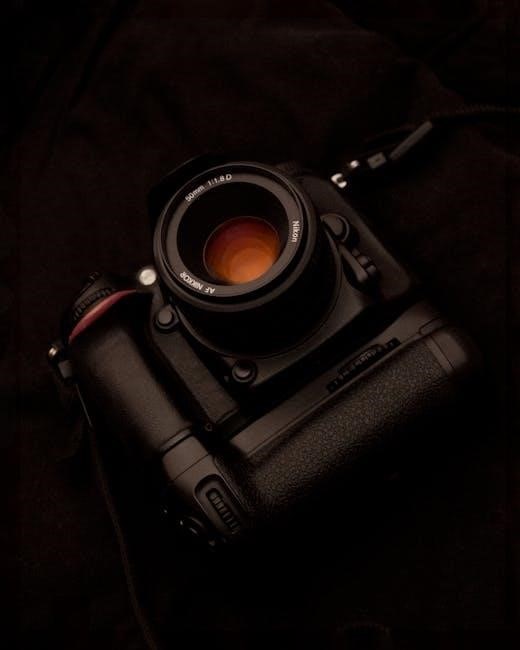
Automatic Modes
The Nikon D3300 features automatic modes designed to simplify photography for users of all skill levels. The Auto Mode allows the camera to handle most settings, ensuring well-balanced images in various conditions. Additionally, the Auto (Flash Off) Mode disables the flash, ideal for situations where flash photography is not permitted. The camera also offers Scene Modes, which optimize settings for specific scenarios like Portrait, Landscape, and Close-up. These modes enable photographers to focus on composition and creativity while the camera adjusts technical details. With these automatic options, users can achieve professional-looking results without manual adjustments, making the D3300 a versatile tool for both beginners and experienced photographers seeking convenience.
Manual and Semi-Manual Modes
The Nikon D3300 offers Manual (M) and Semi-Manual modes for advanced control over photography. In Manual mode, users can adjust both aperture and shutter speed to achieve precise exposures. The Aperture Priority (A/Av) mode allows setting the aperture, while the camera adjusts the shutter speed. Conversely, Shutter Priority (S/Tv) mode lets users set the shutter speed, with the camera controlling the aperture. Programmed Auto (P) mode offers flexibility, enabling adjustments to settings like ISO and white balance while the camera manages exposure. These modes are ideal for experienced photographers seeking creative control. They provide the freedom to experiment with lighting, depth of field, and motion capture, making the D3300 a powerful tool for those who want to push their photography skills to the next level.
Video Recording Capabilities
The Nikon D3300 excels in video recording, offering Full HD resolution at 1080p with frame rates up to 60fps. This ensures smooth and high-quality video capture, ideal for capturing dynamic scenes and motion. The camera supports manual controls during video recording, allowing users to adjust aperture, shutter speed, and ISO for creative flexibility. Additionally, the D3300 features an external microphone input, enhancing audio quality and reducing background noise. Videos are recorded in MPEG-4 AVC/H.264 format, making them compatible with most video editing software. The camera also includes autofocus during recording, though it can be disabled for manual focus control. These features make the D3300 a versatile tool for videographers, offering professional-grade video capabilities in an entry-level DSLR. The ability to shoot high-quality video alongside stunning stills makes the D3300 a standout choice for multimedia enthusiasts.
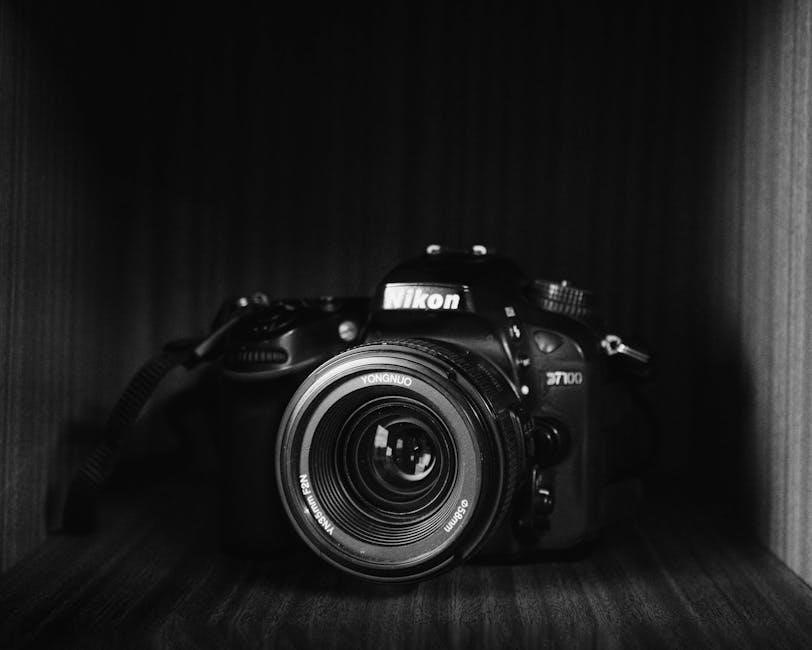
Custom Settings and Configuration
Custom settings on the Nikon D3300 allow users to personalize camera functions, ensuring tailored shooting experiences. This section guides configuring autofocus, metering modes, and other settings for enhanced control and creativity.
Understanding Custom Settings
Custom settings on the Nikon D3300 enable photographers to tailor the camera to their preferences, enhancing shooting efficiency and creativity. These settings allow adjustments to autofocus modes, metering options, and exposure controls, providing precise control over image capture. By understanding these configurations, users can optimize the camera’s performance for various shooting scenarios, ensuring consistent results. The manual details how to access and modify these settings through the menu system, offering insights into personalizing the camera for individual photographic styles. This section is essential for unlocking the D3300’s full potential, helping photographers achieve professional-grade outcomes with ease and confidence.
Configuring Autofocus
Configuring autofocus on the Nikon D3300 ensures precise and efficient focusing, adapting to various subjects and shooting conditions. The camera offers multiple autofocus modes, including Single AF, Continuous AF, and Auto AF, each suited for different scenarios. By understanding these modes and customizing AF settings, photographers can achieve sharp images consistently. The manual provides detailed instructions on selecting focus points, adjusting AF sensitivity, and utilizing advanced features like focus locking. Additionally, it explains how to fine-tune autofocus for specific lenses, optimizing performance for both stills and video. Properly configuring autofocus enhances overall camera responsiveness, making it easier to capture fleeting moments and maintain focus on dynamic subjects.
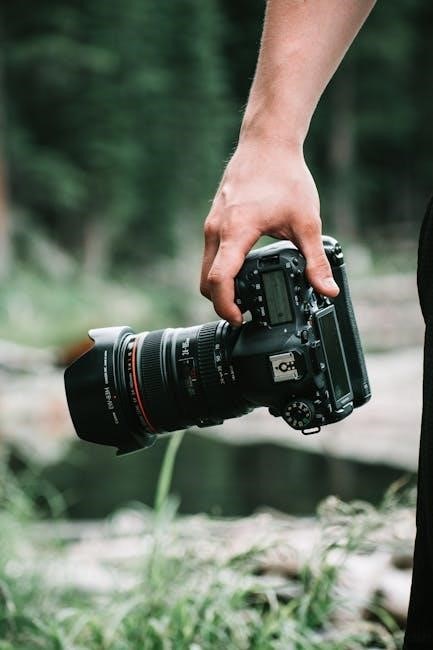
Troubleshooting and Maintenance
The Nikon D3300 manual provides solutions for common issues and maintenance tips to ensure optimal performance. Regular sensor cleaning and firmware updates help maintain camera functionality and image quality effectively.
Common Issues and Solutions
The Nikon D3300 manual addresses various common issues photographers may encounter. One frequent problem is error messages related to lens or memory card issues, which can often be resolved by ensuring proper connections or formatting the memory card. Another issue is blurry images, typically caused by incorrect autofocus settings or shaky hands, which can be fixed by using a tripod or adjusting settings like ISO and shutter speed. Additionally, the manual provides guidance on resolving sensor dust problems, recommending regular cleaning and proper handling techniques. Firmware updates are also emphasized to maintain optimal camera performance and compatibility with accessories. By following the troubleshooting steps outlined, users can quickly identify and resolve issues, ensuring uninterrupted photography sessions and high-quality results. Regular maintenance, as described in the manual, helps prevent these issues from arising in the first place.
Cleaning the Camera Sensor
Cleaning the camera sensor is essential for maintaining image quality. The Nikon D3300 manual provides detailed guidance on this process. Start by using a blower to gently remove loose dust particles. For more stubborn debris, manual cleaning with specialized swabs and cleaning solutions is recommended. The manual also highlights the importance of using Nikon-approved cleaning tools to avoid damaging the sensor. Additionally, the camera features an automatic cleaning mode that vibrates the sensor to remove dust. Always ensure the camera is turned off and the battery is fully charged before cleaning. Regular maintenance ensures optimal performance and prevents dust from affecting your photos. By following the manual’s instructions, you can keep your sensor clean and your images sharp and distortion-free.
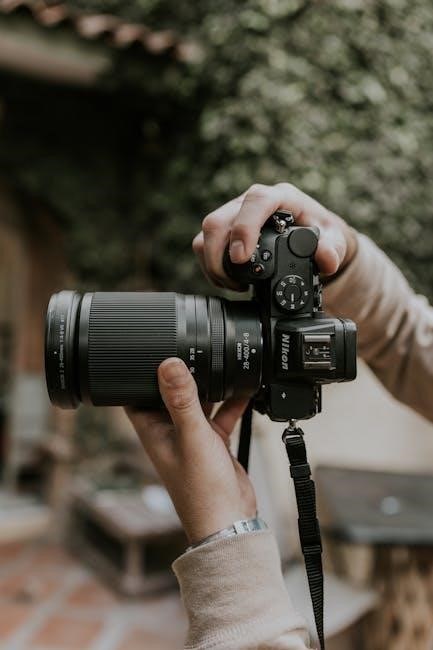
Additional Resources
Nikon’s official support website and the Nikon Manual Viewer 2 app provide easy access to detailed manuals, troubleshooting guides, and software updates for the D3300.
Nikon’s Official Support Website
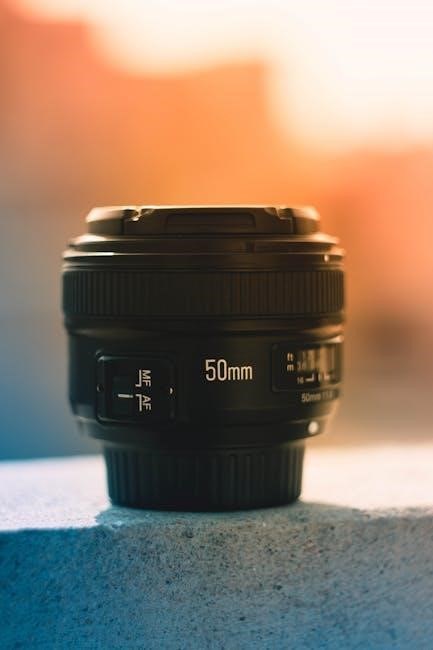
Nikon’s official support website is a go-to resource for D3300 users, offering comprehensive guides, firmware updates, and troubleshooting solutions. It provides direct access to the D3300 reference manual, user manuals, and additional software tools. The website is well-organized, making it easy to navigate and find specific information. Users can download the latest versions of manuals, ensuring they have the most up-to-date guidance for their camera. Additionally, the site includes detailed technical specifications, compatibility information, and FAQs. It also offers resources for Nikon’s suite of software, such as ViewNX 2 and Capture NX-D, which complement the D3300’s functionality. The official support website is an indispensable tool for both novice and advanced photographers, helping them unlock the full potential of their Nikon D3300.
Nikon Manual Viewer 2 App
The Nikon Manual Viewer 2 app is a convenient tool for accessing Nikon camera manuals on-the-go. Available for iOS and Android devices, it allows users to download and view manuals offline, ensuring easy access to guidance anytime. The app is particularly useful for Nikon D3300 users, as it provides a portable reference for understanding camera functions, settings, and troubleshooting. With a user-friendly interface, the app organizes manuals by camera model, making it simple to navigate and find specific information. It supports multiple languages and is free to download from the App Store and Google Play. This app is ideal for photographers who want to master their D3300 without needing to carry the physical manual, offering a seamless way to enhance their photography skills and resolve technical issues efficiently. It’s a must-have companion for both novice and experienced photographers.
